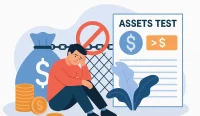Why so many Americans are clinging to their jobs – this is the hidden crisis unfolding in the US labor market, where economic uncertainty has created a perfect storm of job clinging, disengagement, and reduced mobility that’s costing the economy trillions in lost productivity. The US economy has lost 1.2 million jobs since April 2024, and Americans are feeling the economic downturn in ways that are fundamentally changing how they approach their careers.
The quits rate, a measure of how often workers voluntarily leave their jobs, is now down to about 2% after fluctuating in the years since the pandemic. Employers are hiring at the slowest pace since 2013, excluding the pandemic dip and rise. This creates a labor market that doesn’t have a lot of churn, where people want to stay with what is known and not take any risks right now.
The Job Clinging Phenomenon: What It Really Means
The term “job clinging” or “job hugging” describes workers who are staying put rather than moving on to new opportunities. This phenomenon has profound implications for workers, companies, and the broader economy. For workers, it means more stress and less mobility. For companies, it looks like retention, but it hides disengagement. For the economy, it slows innovation because people aren’t moving and growing.
The statistics paint a grim picture of worker satisfaction and engagement. Four out of five employees surveyed said they’re not thriving at work, while another 58% of US professionals surveyed believe they have a wide range of skills that are being underutilized in their current roles. This creates a workforce that’s present but not fully engaged, leading to what economists call “quiet quitting” on a massive scale.
The root cause of this job clinging is economic anxiety. Almost 1 in 5 job seekers surveyed said they’re not confident that they will find a great job that they like. This uncertainty is manifesting itself in fewer people quitting, as well as fewer organizations hiring, creating a frozen labor market with limited opportunities for growth and advancement.
The Economic Factors Driving Job Clinging
Several economic factors are contributing to the job clinging phenomenon:
• Wage growth has cooled – Workers aren’t seeing the same salary increases they once did
• Job switching premiums have shrunk – The financial benefits of changing jobs have decreased
• Rising costs vs. stagnant wages – Workers worry their pay won’t keep up with inflation
• Economic policy uncertainty – Companies are unsure about tariffs and other policies
• Hiring freezes and attrition – Many companies are choosing not to hire rather than lay off
Companies are nervous to hire people when they’re not sure if they’re going to have to turn around and let people go in the near future. This creates a cycle where both workers and employers are playing it safe, leading to reduced economic activity and innovation.
The result is a labor market where workers cling to stability in a time of uncertainty, even if it means staying in jobs where they’re not fully engaged or utilizing their skills. This creates a mismatch between worker capabilities and job requirements, leading to widespread underutilization of talent.
The Hidden Costs of Job Clinging
While job clinging may seem like a safe strategy, it comes with significant hidden costs for both workers and employers. A February 2025 study estimated that for a typical 1,000-person company, employee disengagement adds up to about $5 million a year in lost productivity. The average disengaged worker could cost the company $4,000 over the course of a year, while an executive could cost $20,000.
The network effects of disengagement are particularly concerning. If you have someone who is disengaged, not putting forth the same amount of effort, but is putting forth enough just to stay under the radar, that work still needs to get done. This ends up falling on teammates and other people across the organization, causing additional stress and burnout.
Even if people are engaged and putting forth extra effort, they might have to go even above and beyond to make up for teammates who are disengaged. This creates a cycle where engaged workers become overworked and eventually disengaged themselves, leading to a downward spiral in productivity and morale.
The Middle Management Crisis
Organizations are becoming flatter, with the middle management layer going away. This creates a situation where employees stay put but are disconnected from senior leadership, making them feel directionless and disconnected from the company’s mission and goals.
Forty percent of workers in a recent survey feel directionless, with fewer managers in place to provide guidance and support. This lack of direction leads to workers spinning their wheels, unsure of what they should be working on or how their work contributes to the company’s success.
This has a significant impact on productivity, employee satisfaction, and ultimately a company’s ability to grow and innovate. When workers don’t understand their role in the bigger picture, they’re less likely to take initiative or go above and beyond in their work.
The Broader Economic Impact
The job clinging phenomenon has profound implications for the broader economy and labor market. Globally, low employee engagement is estimated to cost $9.6 trillion annually, or around 9% of global GDP. This represents a massive loss of productivity and economic potential.
Labor mobility has historically been a sign of productivity and innovation. When workers move between jobs, they bring new ideas, skills, and perspectives to their new organizations. They also command higher wages, which drives up overall wage levels and economic growth.
With fewer workers chasing new roles, wage growth flattens, and this reinforces a cycle of caution. This can dampen consumer confidence, reduce the agility of organizations, and limit their ability to innovate and be productive. The result is a stagnant economy where both workers and companies are playing it safe rather than taking the risks necessary for growth.
Breaking the Cycle of Stagnation
Job clinging and low mobility are costing the global economy trillions in lost productivity and innovation. Employers can spark growth by opening new opportunities that inspire workers to move, innovate, and thrive. Post your job on WhatJobs today and connect with ambitious candidates ready to help drive economic momentum.
Post a Job Free for 30 Days →The Erosion of Worker Bargaining Power
The trend of workers staying put has also degraded job seekers’ bargaining power, which can lead to flattened wages. Employers have more power in the labor market, and workers have lost many of the levers they once had to negotiate better terms.
Labor standards have eroded in this country for decades. The minimum wage has been sitting at the same level since 2009, and unionization rates have declined dramatically over the last few decades. When we think about the levers that workers have, they’re pretty limited.
Workers who just a couple of years ago were able to quit their jobs easily and find a much higher paying gig now find themselves in a much different situation. Hiring has slowed down, job openings have come way down, and workers aren’t quitting their jobs nearly as readily. This means workers can’t command raises like they used to.
The Productivity-Wage Divergence
In the three decades following World War II, wages and productivity moved in tandem. When you think about compensation for typical workers, they moved as productivity increased. However, what we’ve seen largely for the last three or four decades is that this relationship has diverged.
As productivity has continued to increase, albeit at a slower pace, workers’ wages have not kept up with those gains. This creates a situation where workers are producing more value but not receiving a proportional increase in compensation, leading to frustration and disengagement.
This divergence between productivity and wages is a key factor in why workers are clinging to their jobs. Even if they’re not fully engaged, they’re afraid that leaving their current job might mean taking a pay cut or not finding a better opportunity elsewhere.
The Entry-Level Job Crisis
New graduates and early career workers may struggle to find entry-level jobs in the current market. Recent college graduates are not finding it as easy to get a new job straight out of college, especially because these are roles where there’s fear that AI is disrupting those jobs.
Entry-level jobs are often stepping stones to more skilled positions down the road, but they’re also low-hanging fruit for AI to come in and disrupt. This creates a situation where the traditional career progression path is being disrupted, making it harder for young workers to get their foot in the door.
However, this could also be an opportunity for innovative companies to pivot. The Gen Z workforce and entry-level workforce are much more moldable and teachable. They’re bright, sharp, street smart, and know how to use technology. This gives hope that with the right leadership and training, these workers can be retooled for the AI-powered economy.
Strategies for Breaking the Job Clinging Cycle
Career coaches recommend focusing on career growth even if you’re not able to find a new job. This means looking for opportunities to improve your skills, do things within your organization to boost your career growth and opportunities, and prepare for when new opportunities come along.
The key is to avoid complacency. If you cling to your job and get a little bit too complacent, that’s not good either, because then your employer can look at you as sort of low-hanging fruit for layoffs in the event that they eventually need to do that.
Instead, workers should focus on:
• Skill development – Learning new technologies and capabilities
• Internal mobility – Looking for opportunities within their current organization
• Networking – Building relationships that could lead to future opportunities
• Visibility – Making sure their contributions are recognized and valued
The Path Forward: Opportunities in Crisis
While the job clinging phenomenon presents significant challenges, it also creates opportunities for those who are willing to adapt and take calculated risks. Companies that can figure out how to re-engage their workforce and leverage technology effectively will have a significant competitive advantage.
The key is to see this as an opportunity rather than just a crisis. With the right leadership in place, the right lean workforce, and effective use of technology and innovation, companies can grow and scale faster than ever before.
For workers, the key is to stay engaged, continue learning, and be ready to pivot when opportunities arise. The labor market may be frozen now, but it won’t stay that way forever, and those who are prepared will be in the best position to take advantage of new opportunities when they emerge.
Frequently Asked Questions
Why are so many Americans clinging to their jobs?
Americans are clinging to their jobs due to economic uncertainty, with the US economy losing 1.2 million jobs since April 2024, wage growth cooling, job switching premiums shrinking, and workers worrying their pay won’t keep up with rising costs.
What is job clinging and how does it affect the economy?
Job clinging refers to workers staying put rather than moving to new opportunities, which reduces labor mobility, slows innovation, masks disengagement, and costs the global economy $9.6 trillion annually in lost productivity.
How does job clinging affect worker productivity?
Job clinging leads to disengagement, with four out of five employees not thriving at work and 58% feeling their skills are underutilized, costing companies $5 million annually in lost productivity for a typical 1,000-person company.
What are the hidden costs of job clinging for companies?
Hidden costs include $4,000 per disengaged worker annually, $20,000 per disengaged executive, network effects where engaged workers must compensate for disengaged colleagues, and reduced innovation and growth potential.
Why has worker bargaining power decreased?
Worker bargaining power has decreased due to hiring slowdowns, reduced job openings, flattened wage growth, eroded labor standards, declining unionization rates, and employers having more power in the current labor market.
A Real-World Example: Maria’s Journey Through Job Clinging
Maria, a 32-year-old marketing manager, found herself in the exact situation described in the job clinging phenomenon. “I’ve been at the same company for five years, and I know I’m not growing,” she explains. “But every time I think about looking for a new job, I get paralyzed by fear.”
Maria’s story illustrates the psychological impact of job clinging. “I see the news about layoffs and economic uncertainty, and I think, ‘What if I leave and can’t find anything better?'” she says. “So I stay put, even though I know I’m not using my full potential.”
After six months of feeling stuck, Maria decided to take a different approach. “Instead of looking for a new job, I started looking for new opportunities within my current company,” she explains. “I volunteered for cross-functional projects, learned new skills, and made sure my contributions were visible to senior leadership.”
Within a year, Maria had been promoted to a senior role with more responsibility and better compensation. “The key was to stop thinking about job clinging as a problem and start thinking about it as an opportunity to grow where I was,” she says.
Maria’s story shows that job clinging doesn’t have to be a dead end. With the right mindset and approach, workers can find ways to grow and advance even in a challenging economic environment.
Don’t Let Job Clinging Hold You Back
The job clinging phenomenon is real and affects millions of American workers, but it doesn’t have to define your career. While economic uncertainty may make it feel safer to stay put, the real risk is becoming complacent and disengaged in a job that doesn’t utilize your full potential.
The key is to focus on what you can control: your skills, your network, and your visibility within your current organization. By staying engaged and continuing to grow, you’ll be in the best position to take advantage of new opportunities when they arise.




